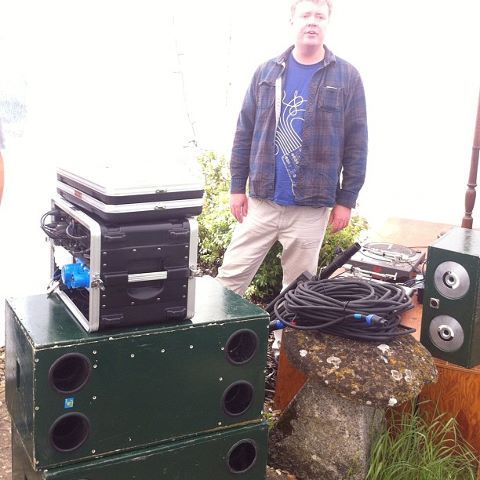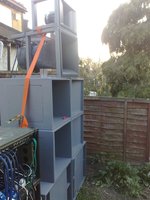- Posts: 236
- Thank you received: 0
S750 compact sub
- jsg
-
 Topic Author
Topic Author
- Offline
- Elite Member
-

Less
More
16 years 10 months ago #5563
by jsg
Ars est celare artem
S750 compact sub was created by jsg
I'm nearly done building a new pair of compact subwoofers.
Some of you may remember seeing Bandpass Bertha, which itself is a little smaller than an X1 but for me it was still too big. I also couldn't build wheels onto it otherwise it would not have fitted into the car, making it a bitch to move around.
So I'm doing a pair of very compact (80*38*45cm) subs, each with a profesional.beyma.com/ingles/pdf/15G450-N.pdf in an 8th order bandpass (I was originally going to use a 12" but it turns out a 15" cone is a better fit if the BL is high).
These will hopefully deliver the "punchy" sound without sacrificing bottom end. I always aim to control in-band group delay and avoid a group delay peak at the top end, but these subs additionally have a high upper cutoff of about 220Hz (subject to a little in-band tilt). I'm gigging them Saturday, so we'll see how that goes...
Some of you may remember seeing Bandpass Bertha, which itself is a little smaller than an X1 but for me it was still too big. I also couldn't build wheels onto it otherwise it would not have fitted into the car, making it a bitch to move around.
So I'm doing a pair of very compact (80*38*45cm) subs, each with a profesional.beyma.com/ingles/pdf/15G450-N.pdf in an 8th order bandpass (I was originally going to use a 12" but it turns out a 15" cone is a better fit if the BL is high).
These will hopefully deliver the "punchy" sound without sacrificing bottom end. I always aim to control in-band group delay and avoid a group delay peak at the top end, but these subs additionally have a high upper cutoff of about 220Hz (subject to a little in-band tilt). I'm gigging them Saturday, so we'll see how that goes...
Ars est celare artem
Please Log in or Create an account to join the conversation.
- giveortake
-

- Offline
- Administrator
-

Less
More
- Posts: 563
- Thank you received: 25
16 years 9 months ago #5597
by giveortake
What is your philosophy of life or your creed ?
\"Have a good time, ALL THE TIME\"
Wisdom is better than silver and gold !
Replied by giveortake on topic S750 compact sub
How did it go? Did it meet your expectations smiley15
The specs are promising, it's a very small box!
I have added the driver in the Resources .
The specs are promising, it's a very small box!
I have added the driver in the Resources .
What is your philosophy of life or your creed ?
\"Have a good time, ALL THE TIME\"
Wisdom is better than silver and gold !
Please Log in or Create an account to join the conversation.
- jake_fielder
-

- Offline
- Elite Member
-

Less
More
- Posts: 170
- Thank you received: 0
16 years 9 months ago #5598
by jake_fielder
Replied by jake_fielder on topic S750 compact sub
Cool, whats the efficiency like, and how low does it go?? Good stuff, im eagerly awaiting photos....
Please Log in or Create an account to join the conversation.
- jsg
-
 Topic Author
Topic Author
- Offline
- Elite Member
-

Less
More
- Posts: 236
- Thank you received: 0
16 years 9 months ago #5664
by jsg
Ars est celare artem
Replied by jsg on topic S750 compact sub
As modelled, efficiency is 99.5dB 1 nom watt@1 metre single unit in halfspace, but overall efficiency in subs is complicated. I think the method of calculation ties in with usual published figures by honest manufacturers but comparitive measurement is the only real way to pin this number down.
Frequency response goes from 43Hz to 215Hz -3dB according to my models, but my figures tend to be conservative compared to measurement, so you might measure to 40Hz or lower. Also, the B chamber port resonance is bang-on 40Hz, so you can EQ around 40 without worrying about cone excursion (though you might worry about B port velocity instead, since it can reach 30m/s)
As for the top end, I've managed to design away a top-end hump in the group delay. Group delay in a bandpass is like a camel. At high frequencies it tends down to zero (the tail). At low frequencies it rises to a positive constant value (the head). In between, you get one or two humps. A en.wikipedia.org/wiki/Bactrian_camel has two humps, and each corresponds to the bend in the frequency response at the top and bottom of the band, respectively. But the top end can be tuned in a Bessel-like fashion and this gets rid of the top-end hump. I haven't managed to tune out the boittom end hump yet (I think it's impossible). So we're left with a en.wikipedia.org/wiki/Dromedary type GD curve.
GD that is flat over a range of frequencies (say an octave or more) corresponds to regular delay as found in processors, horn ducts (at least when the mouth terminates fully) and by standing further away from the speakers. So if the GD can be flat from above the top of the band down to some frequency Fgd, then that's just the same as zero group delay, plus standing say 4 feet further back. Alignment is then the same as with a horn bin - you delay the tops by the same amount.
At the bottom, there's still a GD peak. But then again, every speaker has that peak, and you can only reduce it by compromising LF extension, which may be a compromise too far in compact subs designed for sub-heavy dance music (eg Old-Skool Rave, Psychedelic Trance etc).
All the above is stuff I've been ranting on about for ages. This design has another advantage over the generic bandpass, which came largely by lucky chance resulting from what was originally a design flaw. Feeling that 95 litres internal was not enough for an 8th order bandpass around a 15" inch driver, I opted instead for series-tuned 6th order. But for historical resons, I already had the outer shells and wanted to keep them, thus fixing external dims and port locations. Without going into mechanical details, I was concerned about parasitic inertience near the front of the driver cone, and so decided to model as 8th order with the parasitic inertience as the A port and splitting nominal front chamber into A and C chambers. This left me with a high A tuning of 200+Hz (which I believed would be out-of-band and have a marginal effect on response (basically a useless response peak in the high 200s, that would have to be filtered out).
But Z measurement showed that while I was right to expect to see *something* I had to modify the model to match what was actually happening. This meant taking a *lot* of mass off the driver as well as tweaking the amount of parasitic inertience. I'm not sure why the driver mass reduction is so big, part of it could be that driver manufacturers' method of measurement includes the acoustic "end correction" that results from the bulk of free air in front of and behind the driver - and when you constrain the driver in a tight chamber, the loading you impose partially *substitutes* rather than purely *adds* to the specified Mms. But the amount of mass I had to subtract seems like more than I'd expect to see from this mechanism alone. Could be a distributed effect (ie failure of lumped approximation) that has led me to account for part of the cone mass in the modelled parasitic A port.
Anyway, I get a flat response up to about 100Hz-ish, followed by a smooth drop at 2dB per octave (shallow) up to around 220Hz, whereupon I transition to the expected 24dB/octave drop. The 2dB range has good GD behaviour and so should be useful from a sound quality perspective, adding subjective "speed" and assising in integration by avoiding artifacts in crossover transisiton regions. It certainly helps with the commonly used trick of overlapping the sub/low-mid system.
However, I would advise against using these at power up to 200+Hz eg for crossing to compact horn mids that can't go below 200Hz. This is because you would want boost to compensate for the gradual dip, undermining the efficiency proposition (especially considering decent tops or kick bins ought to be >100dB in this range). Also, the internal mechanism above about 130Hz is for the parasitic A resonator to boost the signal (volume velocity) and then the final C system actually attenuates it again. So you're developing high in-cabinet SPLs for lower amounts of output, and so I would expect distortion to kick in ay high powers.
It's best to consider it a dedicated sub in that it's mostly meant to deliver sub 100Hz output, but that it's easy to crossover to tops and hopefully doesn't have the slowness that people dislike so much. Of course, the latter is subjective - perhaps we should be talking about some blind or double blind tests?
Here's a pic:
Frequency response goes from 43Hz to 215Hz -3dB according to my models, but my figures tend to be conservative compared to measurement, so you might measure to 40Hz or lower. Also, the B chamber port resonance is bang-on 40Hz, so you can EQ around 40 without worrying about cone excursion (though you might worry about B port velocity instead, since it can reach 30m/s)
As for the top end, I've managed to design away a top-end hump in the group delay. Group delay in a bandpass is like a camel. At high frequencies it tends down to zero (the tail). At low frequencies it rises to a positive constant value (the head). In between, you get one or two humps. A en.wikipedia.org/wiki/Bactrian_camel has two humps, and each corresponds to the bend in the frequency response at the top and bottom of the band, respectively. But the top end can be tuned in a Bessel-like fashion and this gets rid of the top-end hump. I haven't managed to tune out the boittom end hump yet (I think it's impossible). So we're left with a en.wikipedia.org/wiki/Dromedary type GD curve.
GD that is flat over a range of frequencies (say an octave or more) corresponds to regular delay as found in processors, horn ducts (at least when the mouth terminates fully) and by standing further away from the speakers. So if the GD can be flat from above the top of the band down to some frequency Fgd, then that's just the same as zero group delay, plus standing say 4 feet further back. Alignment is then the same as with a horn bin - you delay the tops by the same amount.
At the bottom, there's still a GD peak. But then again, every speaker has that peak, and you can only reduce it by compromising LF extension, which may be a compromise too far in compact subs designed for sub-heavy dance music (eg Old-Skool Rave, Psychedelic Trance etc).
All the above is stuff I've been ranting on about for ages. This design has another advantage over the generic bandpass, which came largely by lucky chance resulting from what was originally a design flaw. Feeling that 95 litres internal was not enough for an 8th order bandpass around a 15" inch driver, I opted instead for series-tuned 6th order. But for historical resons, I already had the outer shells and wanted to keep them, thus fixing external dims and port locations. Without going into mechanical details, I was concerned about parasitic inertience near the front of the driver cone, and so decided to model as 8th order with the parasitic inertience as the A port and splitting nominal front chamber into A and C chambers. This left me with a high A tuning of 200+Hz (which I believed would be out-of-band and have a marginal effect on response (basically a useless response peak in the high 200s, that would have to be filtered out).
But Z measurement showed that while I was right to expect to see *something* I had to modify the model to match what was actually happening. This meant taking a *lot* of mass off the driver as well as tweaking the amount of parasitic inertience. I'm not sure why the driver mass reduction is so big, part of it could be that driver manufacturers' method of measurement includes the acoustic "end correction" that results from the bulk of free air in front of and behind the driver - and when you constrain the driver in a tight chamber, the loading you impose partially *substitutes* rather than purely *adds* to the specified Mms. But the amount of mass I had to subtract seems like more than I'd expect to see from this mechanism alone. Could be a distributed effect (ie failure of lumped approximation) that has led me to account for part of the cone mass in the modelled parasitic A port.
Anyway, I get a flat response up to about 100Hz-ish, followed by a smooth drop at 2dB per octave (shallow) up to around 220Hz, whereupon I transition to the expected 24dB/octave drop. The 2dB range has good GD behaviour and so should be useful from a sound quality perspective, adding subjective "speed" and assising in integration by avoiding artifacts in crossover transisiton regions. It certainly helps with the commonly used trick of overlapping the sub/low-mid system.
However, I would advise against using these at power up to 200+Hz eg for crossing to compact horn mids that can't go below 200Hz. This is because you would want boost to compensate for the gradual dip, undermining the efficiency proposition (especially considering decent tops or kick bins ought to be >100dB in this range). Also, the internal mechanism above about 130Hz is for the parasitic A resonator to boost the signal (volume velocity) and then the final C system actually attenuates it again. So you're developing high in-cabinet SPLs for lower amounts of output, and so I would expect distortion to kick in ay high powers.
It's best to consider it a dedicated sub in that it's mostly meant to deliver sub 100Hz output, but that it's easy to crossover to tops and hopefully doesn't have the slowness that people dislike so much. Of course, the latter is subjective - perhaps we should be talking about some blind or double blind tests?
Here's a pic:
Ars est celare artem
Please Log in or Create an account to join the conversation.
- jake_fielder
-

- Offline
- Elite Member
-

Less
More
- Posts: 170
- Thank you received: 0
16 years 9 months ago #5665
by jake_fielder
Replied by jake_fielder on topic S750 compact sub
Really informative and detailed post!! I'd be interested in knowing the results of a blind test. To see if people just assume bandpass to sound slower, It could be compared to a purely horn loaded and a ported horn aswell.
Please Log in or Create an account to join the conversation.
- subsoniks
-

- Offline
- Junior Member
-

Less
More
- Posts: 20
- Thank you received: 0
16 years 9 months ago #5688
by subsoniks
Replied by subsoniks on topic S750 compact sub
Bloody great bit of work your doing there jsg, hats off to you.
You mention the shallow rolloff to 220Hz as needing eq to flatten off again, I don't think this would normally be necessary as it is not unusual for live sound and sound system use to have a rising response from around 220Hz with a hump from around 100Hz down.
I also think that apart from group delay, Bandpass bins have got a bad name through being poorly tuned to be as loud as possible and hence ringing like a bell as well as being a bitch to get the xovers integrated well. I think the reason why some of the more successful Bandpass designs have succeeded is because the designers have designed the the xovers/filters and box as a whole rather than build a good sounding box and use off the shelf filters (LR, Butterworth ,Bessel) and hoped it would still sound good.
Many seem to think that bass bins need to be crossed over below 150Hz to sound good, maybe because that is the way most of the large touring type systems do it, this I believe has a lot to do with having the mid tops seperated from the bass cabinets as using higher xover points makes the system sound disjointed.
I am a big fan of the 40/50Hz-250Hz being covered by one driver as especially for dance music having a the upper and lower bass split can really mess it up and takes a lot of work to get it to sound and feel right, set it up at a different venue with a different amount of cabs or stacked differently, a change of boundary conditions etc and the integration of the bass is often less than optimal. For smaller systems where the bass and midtops are close coupled you don't need to use the lower xover frequencies that compromises the bass and can mess up the attack and general feel and sound of the bass.
Nice one
JaKe
You mention the shallow rolloff to 220Hz as needing eq to flatten off again, I don't think this would normally be necessary as it is not unusual for live sound and sound system use to have a rising response from around 220Hz with a hump from around 100Hz down.
I also think that apart from group delay, Bandpass bins have got a bad name through being poorly tuned to be as loud as possible and hence ringing like a bell as well as being a bitch to get the xovers integrated well. I think the reason why some of the more successful Bandpass designs have succeeded is because the designers have designed the the xovers/filters and box as a whole rather than build a good sounding box and use off the shelf filters (LR, Butterworth ,Bessel) and hoped it would still sound good.
Many seem to think that bass bins need to be crossed over below 150Hz to sound good, maybe because that is the way most of the large touring type systems do it, this I believe has a lot to do with having the mid tops seperated from the bass cabinets as using higher xover points makes the system sound disjointed.
I am a big fan of the 40/50Hz-250Hz being covered by one driver as especially for dance music having a the upper and lower bass split can really mess it up and takes a lot of work to get it to sound and feel right, set it up at a different venue with a different amount of cabs or stacked differently, a change of boundary conditions etc and the integration of the bass is often less than optimal. For smaller systems where the bass and midtops are close coupled you don't need to use the lower xover frequencies that compromises the bass and can mess up the attack and general feel and sound of the bass.
Nice one
JaKe
Please Log in or Create an account to join the conversation.
- ETS
-

- Offline
- New Member
-

Less
More
- Posts: 2
- Thank you received: 0
14 years 2 weeks ago #16121
by ETS
Replied by ETS on topic S750 compact sub
Hi mates please it's important
can u send to me the complete plan? or the link for download it?
..i didn't find S750 plans pdf with complete sheet data.
i need it!! best mid low i think
Respect
Dee
can u send to me the complete plan? or the link for download it?
..i didn't find S750 plans pdf with complete sheet data.
i need it!! best mid low i think
Respect
Dee
Please Log in or Create an account to join the conversation.
- pwoody
-

- Offline
- New Member
-

Less
More
- Posts: 9
- Thank you received: 0
14 years 1 week ago #16130
by pwoody
Replied by pwoody on topic S750 compact sub
i get so confused when i hear people talking about subs going up to 200.... why? thats no longer sub, its low mid. IMO, subs should be stopping at 130 at the top end of their range, and some beefy mids take over to 800, then high mids to 3.2, and highs doin the rest. YMMV.
Please Log in or Create an account to join the conversation.
- bee
-

- Offline
- Platinum Member
-

Less
More
- Posts: 2090
- Thank you received: 34
14 years 1 week ago #16131
by bee
Replied by bee on topic S750 compact sub
you have to break it down a bit more than that. Look at size of system and the use of a system. This cab works great in a two cab set up, tops and sub. They sound very good and are ideal for small partys and venues up to 100 people. where size of venue and room is an issue this type of cab comes into its own. The tops for this sub are very small and could be hidden in a venue with ease and even hung from a low ceiling. The sub could be fitted under seating or fitted in to wall to keep hidden and out of site. The tops i think are 6" drivers. so by taking up the sub can be far better than getting the tops to play low. This helps to keep spl high.... this sub and the tops where on demo at the last fsp speaker meet, and sounded great for there size, with very good spl........ The clarity in the tops and sub combined were very good, the comment of the meet was the bar man going wow those speakers sound great, pointing to the big stack in the corner..... he looked shocked when i said they are not on, its the small green ones....... For bigger stacks yes i agree you would cross sub out between 90hz and 120hz max into kicks upto 150hz then into mids upto 1.2khz then to hf 6khz and then into your tweeters....
Please Log in or Create an account to join the conversation.
Time to create page: 0.236 seconds
